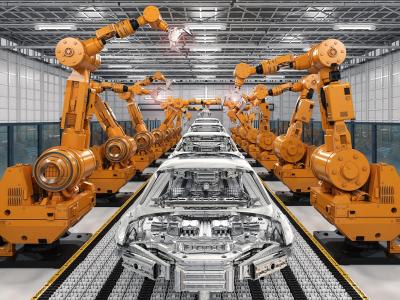The electric vehicle (EV) era is arriving. Manufacturers are already transitioning their business models in anticipation of the full global adoption of EVs, hybrids, and new client service models. Not since the invention of on-board computers has the automotive industry taken such an evolutionary leap, and it is poised to transform the entire industry.
Yet, the mobility industry is facing several lingering challenges at the dawn of the electric vehicle age. What infrastructure issues will we face transitioning from a combustion engine world to an electric one? How will EV manufacturers be impacted on the local and regional level? How will the needs of the EV customer base evolve in the next ten years? To address some of these questions, the automotive industry is turning to an age-old ally: technology.
A whole new world
To give you an idea of how EVs will change the world, one need only to look at the invention of the aeroplane or the combustion engine. These technological advances transformed life as we knew it, virtually overnight, and EVs will be no different. However, before we can enjoy the benefits of EVs, we must first make some changes ourselves. The first step is to re-examine our entire transportation infrastructure.
The word “ecosystem” is used a lot to describe the network of different players, components, and vehicles, all of which interact with and derive value from each other. Interestingly, the EV ecosystem is even greater than the sum of its parts, providing value beyond that of just the vehicles, drivers, and manufacturers. The cumulative network effect of having multiple customers, charging stations, and other technology partners creates an entire industry with far-reaching benefits: employment, cleaner air, mobility, accessibility, convenience, and connectivity.
Another challenge will be retrofitting streetscapes that were designed with combustion engines in mind. How will roads change? What will happen to petrol stations? We may see a 50/50 split, with traditional pumps sharing space with charging stations. This will certainly impact their business models, as drivers may not be willing to pay as much to charge an EV as they are to fill a tank with fossil fuels. Then there are car parks and parking spaces – will these now be retrofitted with charging stations as well? The transition will not be easy and will require significant investments up front.
Demand is stuck in neutral
As with any exciting new technological revolution, there will be challenges. Asia and the EU continue to show promising signs of full-scale consumer adoption, but the United States (arguably the largest auto market in the world) is still lagging far behind. To further complicate matters, the current automotive industry relies on a patchwork of supply chains, many of which are isolated in just a handful of regions.
The supply chains that we do have are incredibly vulnerable to global and regional disruptions. Recent supply chain troubles continue to ripple throughout the manufacturing sector, threatening the viability of large-scale EV production.
The most challenging consumer challenge for EVs to deal with is range anxiety. This is the concern that your vehicle will not be able to complete a trip or that the charging infrastructure will be insufficient across the whole journey. For example, despite the fact that most daily commuters in the United States drive less than 50 miles a day, range anxiety remains the biggest barrier to full-scale adoption. We are going to have to see some major investments in both rapid charging and EV range before these vehicles become commonplace. Governments and manufacturers both have a role to play here.
Interoperability of these new vehicles and the infrastructure required is a final concern for consumers. This is particularly important within EV charging infrastructure. Usually with emerging technologies, there are many different developers creating their own tech standards, and most of the time these different pieces of tech ‘won’t play nicely’ with each other. For example, consider the amount of frustration consumers have expressed with smart phones and tablets using different charging cables. Now imagine their hesitation when considering a five-figure investment. Establishing a universal standard for charging will go a long way towards global consumer adoption.
Thankfully, one of the biggest hurdles faced by EVs has already been cleared: the aesthetics. Older models were boxy and lacked visual appeal – something that has a profound effect on car buyers. However, newer models have embraced design as a vital part of the marketing of these vehicles.
Cars 2.0
The automotive industry is starting to look and behave less like the automotive industry and more like the consumer tech industry. This trend will probably only continue to evolve. Many modern cars are starting to resemble computers. They are packed with sensors, systems, and augmentation that make even cars from the late 2000s look archaic by comparison.
Another thing that modern consumers demand from their technology products is interoperability across apps and platforms. As vehicles become smart devices, drivers will expect it to work with their smartphone seamlessly. They want to use their preferred navigation app or stream entertainment from their favourite platform. It is going to be interesting to see how newer vehicles rolling off the factory floor will be able to handle that demand. Greater levels of technology in the vehicles are taking us closer to a future with self-driving vehicles.
The EV ecosystem represents advancements being made across the entire planet. It is not just the vehicles themselves that are changing, but the adoption of an entire new way of thinking about transportation. Technologies such as augmented reality (AR) and haptic displays will continue to find their way into the auto industry, especially as more and more drivers take their hands off the wheel.
Some auto manufacturers have already introduced heads-up displays (HUDs) for GPS or touchless entertainment systems. As cars become more connected, more digital, and computerised, we will only see greater adoption and evolution of these futuristic technologies.
From a tech standpoint, there are some exciting developments around the corner. Some companies are experimenting with the idea of putting GPS devices in motorcycle helmets. As that technology finds its way into transportation, we may see haptics or HUDs in motorcycle helmet visors, sunglass lenses, or even cycling helmets at scale. Coupled with predictive technology, we could see a world where wearable technology could help motorcycle drivers or cyclists avoid accidents.
The automotive industry has a long track record of pioneering new technologies and making them commonplace. It will be interesting to keep an eye on businesses that can develop automotive-focused solutions and then pivot them across other industries. There are certainly many possibilities for manufacturers to profit from these emerging technologies.
A new model
The technology itself is not the only thing threatening to revolutionise driving. The idea of using subscription models for EVs is raising quite a few eyebrows. Care-by-Volvo is a great example of a subscription model that allows drivers to lease a vehicle in a more flexible manner that aligns with their needs. Crucially, the purchasing experience is completely online, or app driven. You have a choice of delivery or collection from the dealership. The contract terms allow for more flexible cancellation than a traditional agreement if your needs change.
Consumers have become accustomed to a more on-demand, software-as-a-service (SaaS) digital model for many of the products they use. This is how we pay for our video entertainment; it is how we shop online, how we order our food, and it has made us accustomed to being able to order anything we want at the click of a button. However, one potential challenge is that modern consumers crave customisation. There can be challenges in offering or controlling this in a subscription-based business model.
Cars of the future
Ultimately, demand will catch up to the massive expectations we have placed on EVs. Until then, the industry has its work cut out for it. However, if there is one thing auto manufacturers have always done well, it is repackaging an existing product in a much more streamlined, efficient, and technologically advanced manner, and consumers want shiny, new, and improved products. It may take five years, or ten, or even twenty, but the day will come when it is the fossil fuel vehicle that is the exception, not the rule.







